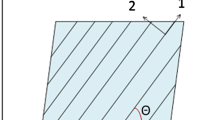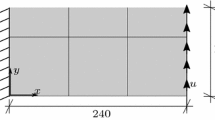Abstract
In this work, the coefficients of thermal expansion (CTEs) of fibers in composite materials that contain microstructures are numerically evaluated using a lamina-scale cost function with quasi-analytical gradients. To consider the effects of fiber arrangements and local defects, such as interface debonding and voids, a variety of representative volume elements are modeled with a number of finite element meshes. Then, the CTEs of fibers are evaluated by minimizing a lamina-scale cost function that represents the difference between the measured CTEs and the computed CTEs by means of a computational homogenization scheme for the composite lamina. The descent direction of the cost function is obtained using quasi-analytical gradients that take partial derivatives from prediction models, such as the Schapery model and Hashin model defined in an explicit manner, which accelerates the minimization procedure. To verify the performance of the proposed scheme in terms of accuracy and efficiency, the CTEs of constituents calculated using the proposed scheme in a unidirectional composite lamina are compared with experimental values reported in the literature. Furthermore, the convergence behavior of the proposed scheme with quasi-analytical gradients is also investigated and compared with other minimization methods.
Similar content being viewed by others
References
C. Farinelli, H.-I. Kim and J.-H. Han, Feasibility study to actively compensate deformations of composite structure in a space environment, Int. J. Aeronaut. Space Sci., 13 (2) (2012) 221–228.
I. M. Daniel and O. Ishai, Engineering mechanics of composite materials, Oxford University Press, New York, USA (1994).
R. A. Schapery, Thermal expansion coefficients of composite materials based on energy principles, J. Compos. Mater., 2 (3) (1968) 380–404.
E. Sideridis, Thermal expansion coefficients of fiber composites defined by the concept of the interphase, Compos. Sci. Technol., 51 (3) (1994) 301–317.
J. C. Halpin, Effects of environmental factors on composite materials, Air Force Material Laboratory Technical Report, AFML-TR-67-423 (1969).
T. Mori and K. Tanaka, Average stress in matrix and average elastic energy of materials with misfitting inclusions, Acta Metall., 21 (5) (1973) 571–574.
T.-W. Chou, S. Nomura and M. Taya, A self-consistent approach to the elastic stiffness of short-fiber composites, J. Compos. Mater., 14 (3) (1980) 178–188.
Z. H. Karadeniz and D. Kumlutas, A numerical study on the coefficients of thermal expansion of fiber reinforced composite materials, Compos. Struct., 78 (1) (2007) 1–10.
S. Li, N. Warrior, Z. Zou and F. Almaskari, A unit cell for FE analysis of materials with the microstructure of a staggered pattern, Compos. Part A: Appl. Sci. Manuf., 42 (7) (2011) 801–811.
S. Li, Boundary conditions for unit cells from periodic microstructures and their implications, Compos. Sci. Technol., 68 (9) (2008) 1962–1974.
R. Islam, S. G. Sjölind and A. Pramila, Finite element analysis of linear thermal expansion coefficients of unidirectional cracked composites, J. Compos. Mater., 35 (19) (2001) 1762–1776.
W. Yu and T. Tang, A variational asymptotic micromechanics model for predicting thermoelastic properties of heterogeneous materials, Int. J. Solids Struct., 44 (22–23) (2007) 7510–7525.
G. P. Choi, D. Sohn, C. H. Woo, S.-H. Lee, S. H. Ahn and Y.-S. Cho, Qualitative verification of the dispersion level in nano-composite and its application to YD-128/MWCNT composite to assess the wear characteristics with respect to the dispersion level, J. Mech. Sci. Technol., 27 (10) (2013) 3131–3138.
X. Liu, R. Wang, Z. Wu and W. Liu, The effect of triangleshape carbon fiber on the flexural properties of the carbon fiber reinforced plastics, Mater. Lett., 73 (2012) 21–23.
S.-J. Park, M.-K. Seo and H.-B. Shim, Effect of fiber shapes on physical characteristics of non-circular carbon fibersreinforced composites, Mater. Sci. Eng. A, 352 (1–2) (2003) 34–39.
H. G. Kim, Effects of fiber aspect ratio evaluated by elastic analysis in discontinuous composites, J. Mech. Sci. Technol., 22 (3) (2008) 411–419.
N. Kuentzer, P. Simacek, S. G. Advani and S. Walsh, Correlation of void distribution to VARTM manufacturing techniques, Compos. Part A: Appl. Sci. Manuf., 38 (3) (2007) 802–813.
H. Huang and R. Talreja, Effects of void geometry on elastic properties of unidirectional fiber reinforced composites, Compos. Sci. Technol., 65 (13) (2005) 1964–1981.
R. Guo, H. Shi and Z. Yao, Modeling of interfacial debonding crack in particle reinforced composites using Voronoi cell finite element method, Comput. Mech., 32 (1–2) (2003) 52–59.
T. Rabczuk and T. Belytschko, Cracking particles: a simplified meshfree method for arbitrary evolving cracks, Int. J. Numer. Methods Eng., 61 (13) (2004) 2316–2343.
Y. Huang, K. K. Jin and S. K. Ha, Effects of fiber arrangement on mechanical behavior of unidirectional composites, J. Compos. Mater., 42 (18) (2008) 1851–1871.
P. Rupnowski, M. Gentz, J. K. Sutter and M. Kumosa, An evaluation of the elastic properties and thermal expansion coefficients of medium and high modulus graphite fibers, Compos. Part A: Appl. Sci. Manuf., 36 (3) (2005) 327–338.
R. Kulkarni and O. Ochoa, Transverse and longitudinal CTE measurements of carbon fibers and their impact on interfacial residual stresses in composites, J. Compos. Mater., 40 (8) (2006) 733–754.
C. Pradere, J. C. Batsale, J. M. Goyheneche, R. Pailler and S. Dilhaire, Estimation of the transverse coefficient of thermal expansion on carbon fibers at very high temperature, Inverse Probl. Sci. Eng., 15 (1) (2007) 77–89.
C. Pradere and C. Sauder, Transverse and longitudinal coefficient of thermal expansion of carbon fibers at high temperatures (300–2500K), Carbon, 46 (14) (2008) 1874–1884.
J.-S. Ban, K.-W. Lee, S.-J. Kim and K.-Z. Cho, A study on the microstructural property and thermal property of Ti-alloys without Al as biomaterials, J. Mech. Sci. Technol., 22 (8) (2008) 1447–1450.
S. Sockalingam and G. Nilakantan, Fiber-matrix interface characterization through the microbond test, Int. J. Aeronaut. Space Sci., 13 (3) (2012) 282–295.
J. Arora, Introduction to optimum design, Academic Press, New York, USA (2004).
E. Kreyszig, Advanced engineering mathematics, 10th edition, John Wiley & Sons, New York, USA (2011).
Z. Hashin, Analysis of properties of fiber composites with anisotropic constituents, J. Appl. Mech., 46 (3) (1979) 543–550.
J. R. Strife and K. M. Prewo, The thermal expansion behavior of unidirectional and bidirectional Kevlar/epoxy composites, J. Compos. Mater., 13 (4) (1979) 264–277.
Matlab User’s Guide (R2012a), MathWorks (2012).
Abaqus Analysis User’s Manual (6.10), Dassault Systèmes (2010).
J. C. Lagarias, J. A. Reeds, M. H. Wright and P. E. Wright, Convergence properties of the Nelder-Mead simplex method in low dimensions, SIAM J. Optim., 9 (1) (1998) 112–147.
A. S. Kaddour, M. J. Hinton, P. A. Smith and S. Li, Mechanical properties and details of composite laminates for the test cases used in the third world-wide failure exercise, J. Compos. Mater., 47 (20–21) (2013) 2427–2442.
T. D. Breitzman, Multiscale strain analysis, Ph.D. Dissertation, Louisiana State University (2005).
H. Miyagawa, T. Mase, C. Sato, E. Drown, L. T. Drzal and K. Ikegami, Comparison of experimental and theoretical transverse elastic modulus of carbon fibers, Carbon, 44 (10) (2006) 2002–2008.
C. Sauder and J. Lamon, Prediction of elastic properties of carbon fibers and CVI matrices, Carbon, 43 (10) (2005) 2044–2053.
Author information
Authors and Affiliations
Corresponding author
Additional information
Recommended by Associate Editor Kyeongsik Woo
Jae Hyuk Lim received his B.S. degree in Mechanical Engineering from Inha University, Korea in 2000. He received his M.S. and Ph.D. degrees in Mechanical Engineering from the Korea Advanced Institute of Science and Technology (KAIST) in 2002 and 2006, respectively. He is currently a senior research engineer in the Satellite Mechanical Department, Korea Aerospace Research Institute. His research interests include finite element simulations, material modeling and characterization, and design and analysis of satellite structures.
Dongwoo Sohn received his B.S. degree from Hanyang University, Korea in 2006. He received his M.S. and Ph.D. degrees from the Korea Advanced Institute of Science and Technology (KAIST) in 2008 and 2011, respectively. He is currently an assistant professor in the Division of Mechanical Engineering, Korea Maritime and Ocean University. His research interests include numerical methods and computational mechanics.
Rights and permissions
About this article
Cite this article
Lim, J.H., Charpentier, JB. & Sohn, D. Numerical evaluation of the coefficients of thermal expansion of fibers in composite materials using a lamina-scale cost function with quasi-analytical gradients. J Mech Sci Technol 29, 1187–1197 (2015). https://doi.org/10.1007/s12206-015-0231-x
Received:
Revised:
Accepted:
Published:
Issue Date:
DOI: https://doi.org/10.1007/s12206-015-0231-x




